Assessment 2: Teamwork, Reflection, and Communication Plan
VerifiedAdded on 2019/11/08
|7
|1395
|150
Report
AI Summary
This report, titled "Assessment 2: Teamwork and Reflection," examines key aspects of leadership, teamwork, and communication within a project management context. It details the design of learning cycles, outlining roles like organizer and scribe, and their responsibilities in meeting agendas. The report further presents a communication plan, specifically for a risk manager, detailing methods and media for sharing information with team members and stakeholders. Finally, a reflection section discusses the importance of leadership qualities, stakeholder relationships, and risk management skills, emphasizing techniques for risk identification, analysis, and mitigation. The report highlights the significance of a project manager's role in fostering teamwork, effective communication, and strategic workforce segmentation, along with the use of various risk analysis tools and techniques to ensure project success.
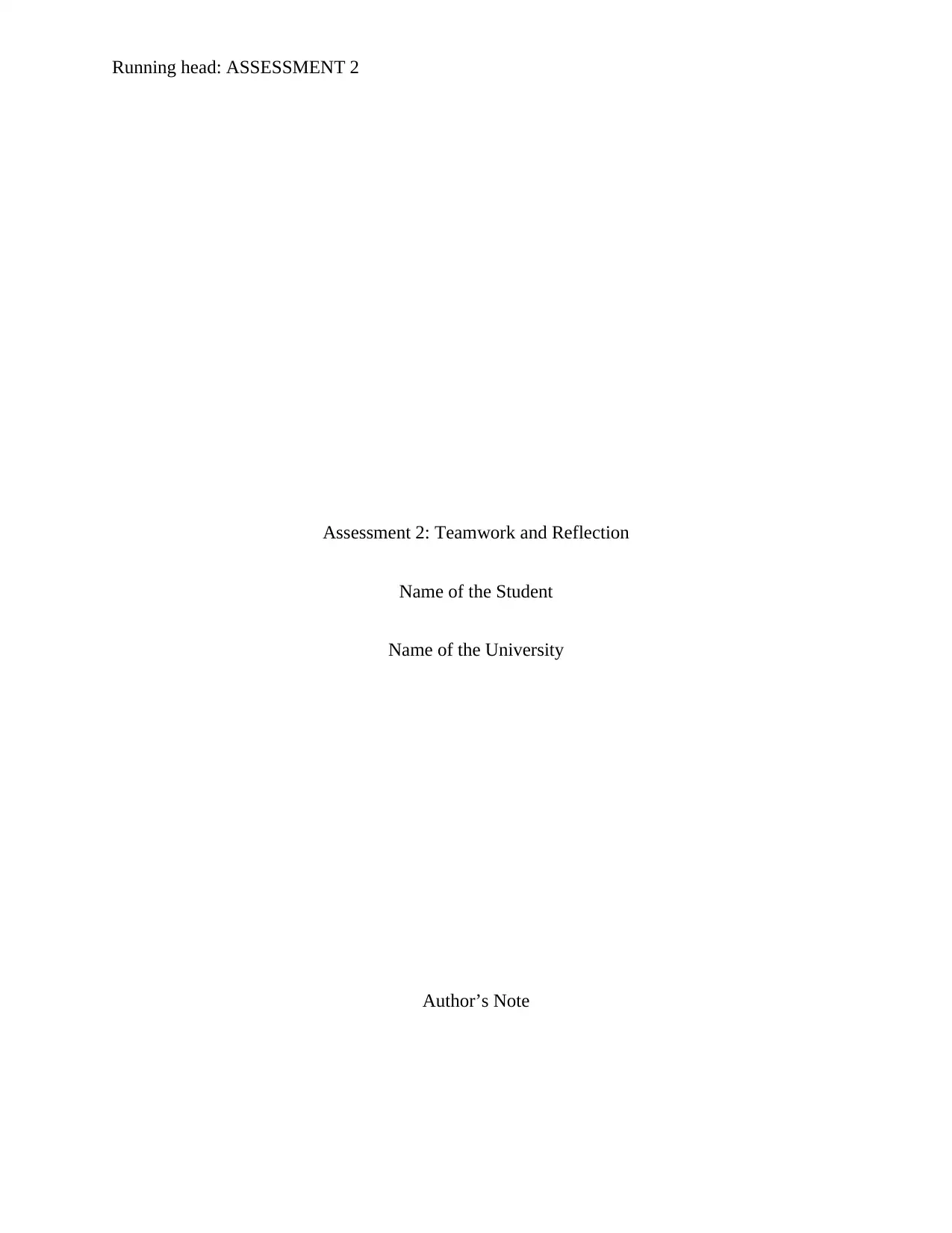
Running head: ASSESSMENT 2
Assessment 2: Teamwork and Reflection
Name of the Student
Name of the University
Author’s Note
Assessment 2: Teamwork and Reflection
Name of the Student
Name of the University
Author’s Note
Paraphrase This Document
Need a fresh take? Get an instant paraphrase of this document with our AI Paraphraser
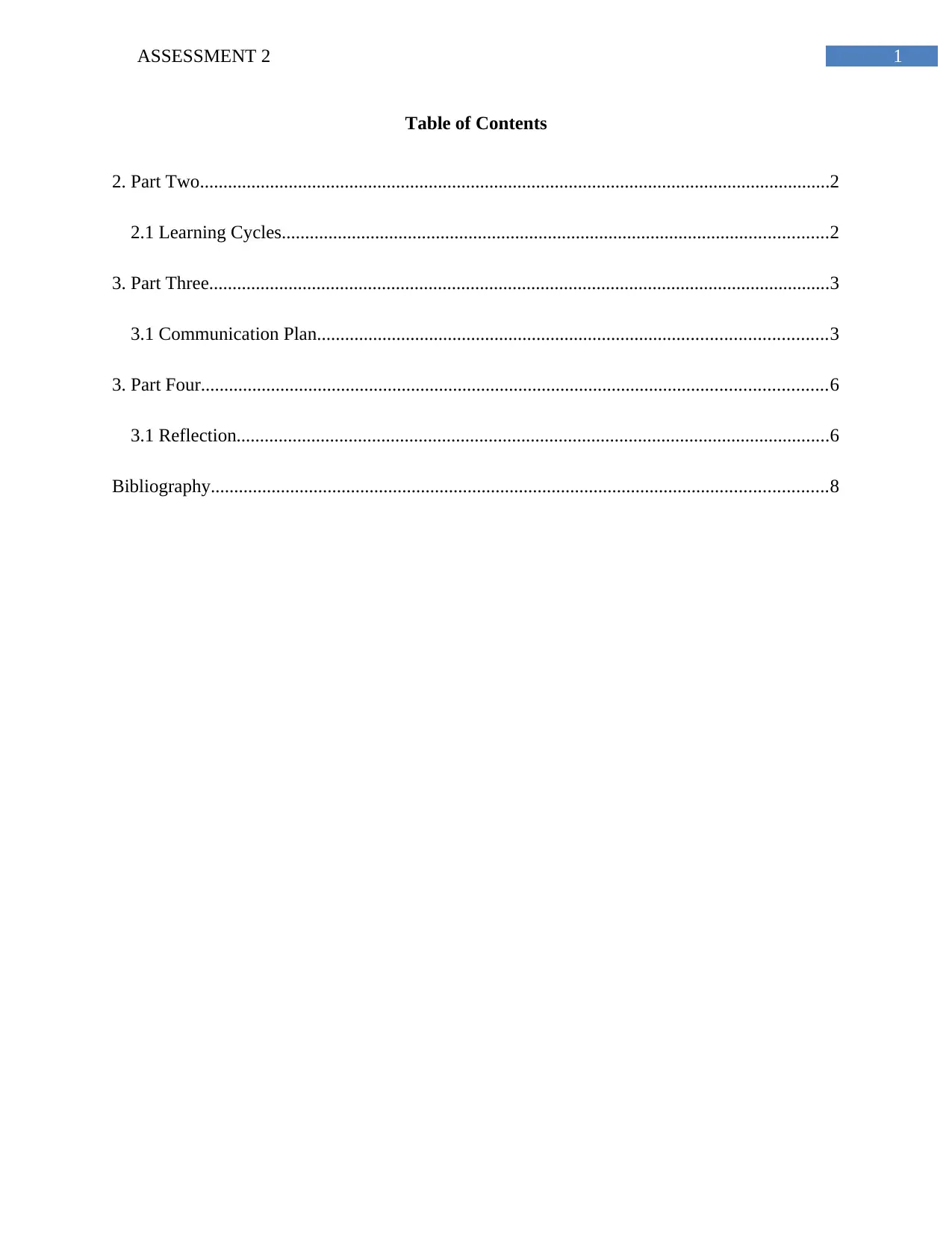
1ASSESSMENT 2
Table of Contents
2. Part Two.......................................................................................................................................2
2.1 Learning Cycles.....................................................................................................................2
3. Part Three.....................................................................................................................................3
3.1 Communication Plan.............................................................................................................3
3. Part Four......................................................................................................................................6
3.1 Reflection...............................................................................................................................6
Bibliography....................................................................................................................................8
Table of Contents
2. Part Two.......................................................................................................................................2
2.1 Learning Cycles.....................................................................................................................2
3. Part Three.....................................................................................................................................3
3.1 Communication Plan.............................................................................................................3
3. Part Four......................................................................................................................................6
3.1 Reflection...............................................................................................................................6
Bibliography....................................................................................................................................8
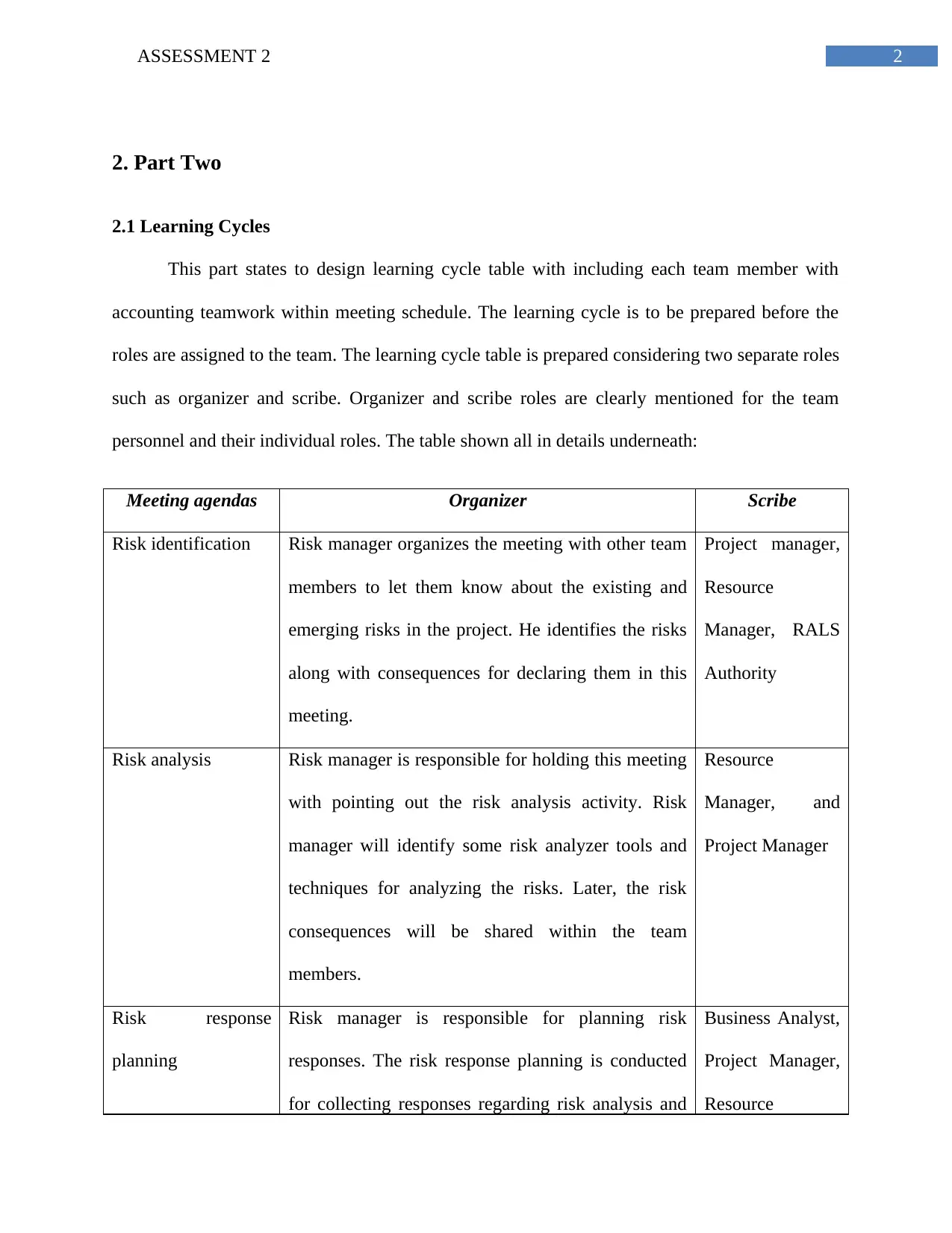
2ASSESSMENT 2
2. Part Two
2.1 Learning Cycles
This part states to design learning cycle table with including each team member with
accounting teamwork within meeting schedule. The learning cycle is to be prepared before the
roles are assigned to the team. The learning cycle table is prepared considering two separate roles
such as organizer and scribe. Organizer and scribe roles are clearly mentioned for the team
personnel and their individual roles. The table shown all in details underneath:
Meeting agendas Organizer Scribe
Risk identification Risk manager organizes the meeting with other team
members to let them know about the existing and
emerging risks in the project. He identifies the risks
along with consequences for declaring them in this
meeting.
Project manager,
Resource
Manager, RALS
Authority
Risk analysis Risk manager is responsible for holding this meeting
with pointing out the risk analysis activity. Risk
manager will identify some risk analyzer tools and
techniques for analyzing the risks. Later, the risk
consequences will be shared within the team
members.
Resource
Manager, and
Project Manager
Risk response
planning
Risk manager is responsible for planning risk
responses. The risk response planning is conducted
for collecting responses regarding risk analysis and
Business Analyst,
Project Manager,
Resource
2. Part Two
2.1 Learning Cycles
This part states to design learning cycle table with including each team member with
accounting teamwork within meeting schedule. The learning cycle is to be prepared before the
roles are assigned to the team. The learning cycle table is prepared considering two separate roles
such as organizer and scribe. Organizer and scribe roles are clearly mentioned for the team
personnel and their individual roles. The table shown all in details underneath:
Meeting agendas Organizer Scribe
Risk identification Risk manager organizes the meeting with other team
members to let them know about the existing and
emerging risks in the project. He identifies the risks
along with consequences for declaring them in this
meeting.
Project manager,
Resource
Manager, RALS
Authority
Risk analysis Risk manager is responsible for holding this meeting
with pointing out the risk analysis activity. Risk
manager will identify some risk analyzer tools and
techniques for analyzing the risks. Later, the risk
consequences will be shared within the team
members.
Resource
Manager, and
Project Manager
Risk response
planning
Risk manager is responsible for planning risk
responses. The risk response planning is conducted
for collecting responses regarding risk analysis and
Business Analyst,
Project Manager,
Resource
⊘ This is a preview!⊘
Do you want full access?
Subscribe today to unlock all pages.

Trusted by 1+ million students worldwide
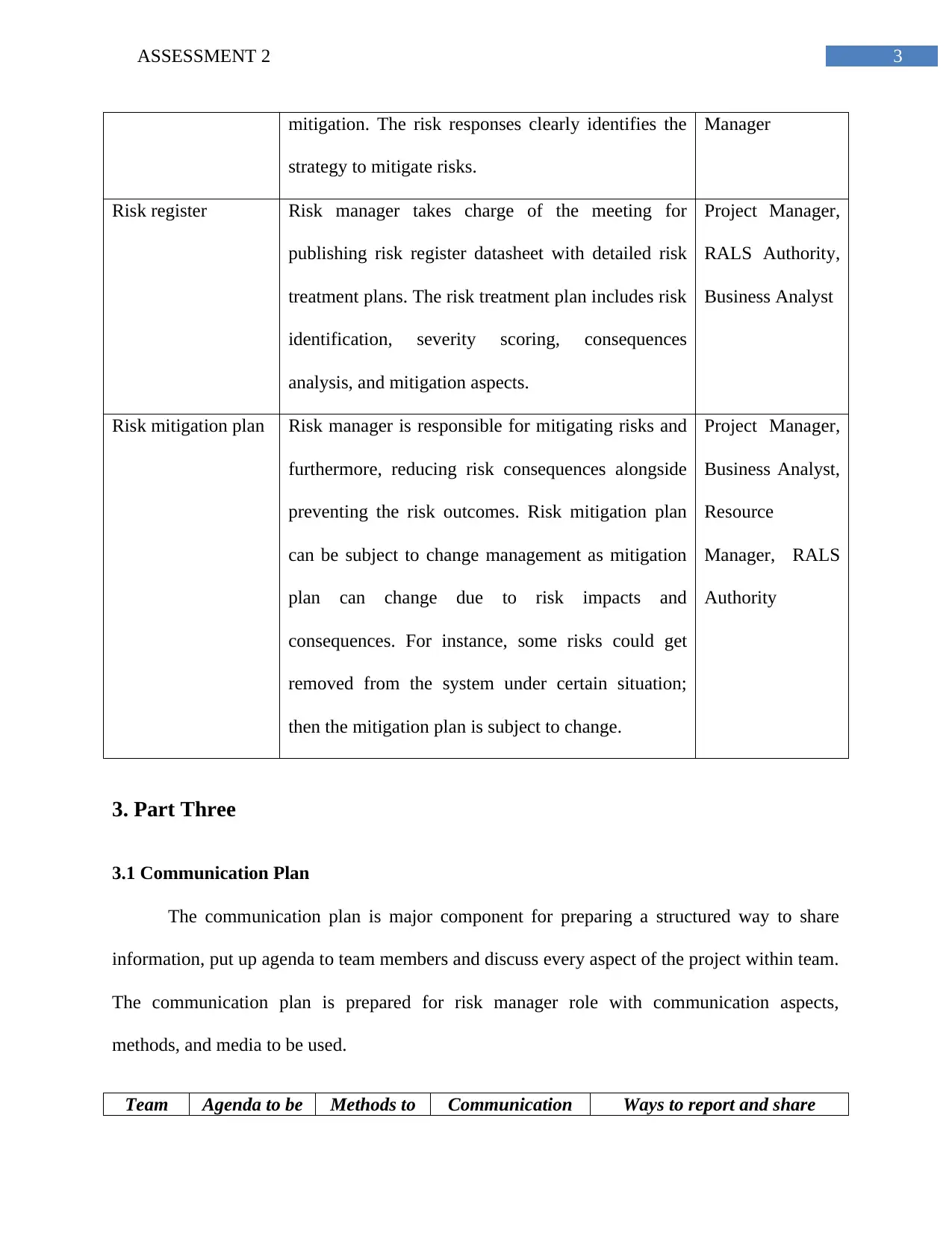
3ASSESSMENT 2
mitigation. The risk responses clearly identifies the
strategy to mitigate risks.
Manager
Risk register Risk manager takes charge of the meeting for
publishing risk register datasheet with detailed risk
treatment plans. The risk treatment plan includes risk
identification, severity scoring, consequences
analysis, and mitigation aspects.
Project Manager,
RALS Authority,
Business Analyst
Risk mitigation plan Risk manager is responsible for mitigating risks and
furthermore, reducing risk consequences alongside
preventing the risk outcomes. Risk mitigation plan
can be subject to change management as mitigation
plan can change due to risk impacts and
consequences. For instance, some risks could get
removed from the system under certain situation;
then the mitigation plan is subject to change.
Project Manager,
Business Analyst,
Resource
Manager, RALS
Authority
3. Part Three
3.1 Communication Plan
The communication plan is major component for preparing a structured way to share
information, put up agenda to team members and discuss every aspect of the project within team.
The communication plan is prepared for risk manager role with communication aspects,
methods, and media to be used.
Team Agenda to be Methods to Communication Ways to report and share
mitigation. The risk responses clearly identifies the
strategy to mitigate risks.
Manager
Risk register Risk manager takes charge of the meeting for
publishing risk register datasheet with detailed risk
treatment plans. The risk treatment plan includes risk
identification, severity scoring, consequences
analysis, and mitigation aspects.
Project Manager,
RALS Authority,
Business Analyst
Risk mitigation plan Risk manager is responsible for mitigating risks and
furthermore, reducing risk consequences alongside
preventing the risk outcomes. Risk mitigation plan
can be subject to change management as mitigation
plan can change due to risk impacts and
consequences. For instance, some risks could get
removed from the system under certain situation;
then the mitigation plan is subject to change.
Project Manager,
Business Analyst,
Resource
Manager, RALS
Authority
3. Part Three
3.1 Communication Plan
The communication plan is major component for preparing a structured way to share
information, put up agenda to team members and discuss every aspect of the project within team.
The communication plan is prepared for risk manager role with communication aspects,
methods, and media to be used.
Team Agenda to be Methods to Communication Ways to report and share
Paraphrase This Document
Need a fresh take? Get an instant paraphrase of this document with our AI Paraphraser
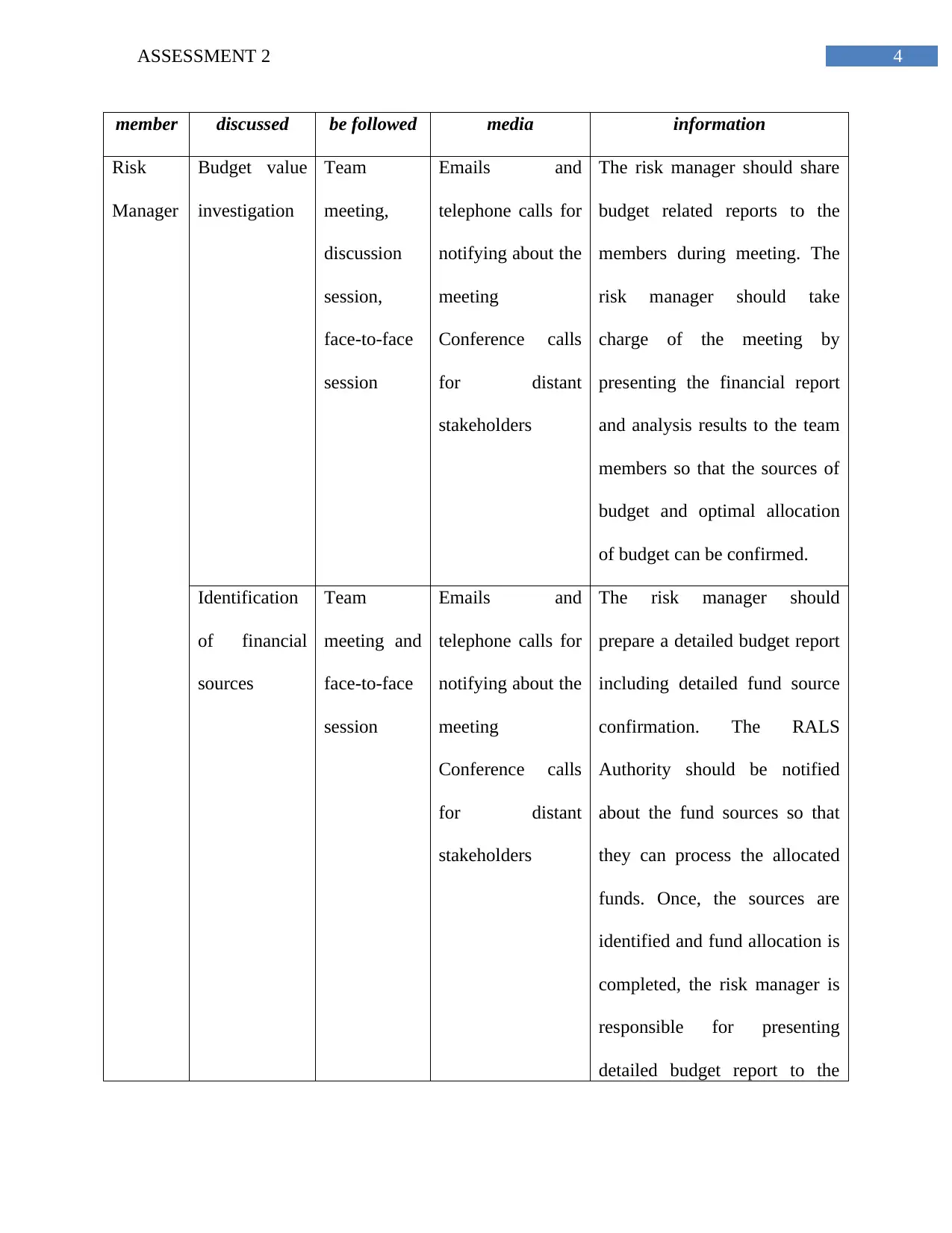
4ASSESSMENT 2
member discussed be followed media information
Risk
Manager
Budget value
investigation
Team
meeting,
discussion
session,
face-to-face
session
Emails and
telephone calls for
notifying about the
meeting
Conference calls
for distant
stakeholders
The risk manager should share
budget related reports to the
members during meeting. The
risk manager should take
charge of the meeting by
presenting the financial report
and analysis results to the team
members so that the sources of
budget and optimal allocation
of budget can be confirmed.
Identification
of financial
sources
Team
meeting and
face-to-face
session
Emails and
telephone calls for
notifying about the
meeting
Conference calls
for distant
stakeholders
The risk manager should
prepare a detailed budget report
including detailed fund source
confirmation. The RALS
Authority should be notified
about the fund sources so that
they can process the allocated
funds. Once, the sources are
identified and fund allocation is
completed, the risk manager is
responsible for presenting
detailed budget report to the
member discussed be followed media information
Risk
Manager
Budget value
investigation
Team
meeting,
discussion
session,
face-to-face
session
Emails and
telephone calls for
notifying about the
meeting
Conference calls
for distant
stakeholders
The risk manager should share
budget related reports to the
members during meeting. The
risk manager should take
charge of the meeting by
presenting the financial report
and analysis results to the team
members so that the sources of
budget and optimal allocation
of budget can be confirmed.
Identification
of financial
sources
Team
meeting and
face-to-face
session
Emails and
telephone calls for
notifying about the
meeting
Conference calls
for distant
stakeholders
The risk manager should
prepare a detailed budget report
including detailed fund source
confirmation. The RALS
Authority should be notified
about the fund sources so that
they can process the allocated
funds. Once, the sources are
identified and fund allocation is
completed, the risk manager is
responsible for presenting
detailed budget report to the

5ASSESSMENT 2
authority.
Planning
about
maintenance
cost
Discussion
session,
face-to-face
session
Emails and
telephone calls for
notifying about the
meeting
Conference calls
for distant
stakeholders
Risk manager is responsible for
create plan about maintenance
process. The planning over
maintenance cost should be
considered based on budget
sources and costing plans as
well. The planning of
maintenance of cost is
significant way to assess
whether the system can have
maintenance cost or not from
allocated budget. Planning for
maintenance cost is to be
managed as per allocated
budget, cost, and other funds
accordingly.
Risk
mitigation
plan
Team
meeting,
discussion
session,
face-to-face
session
Emails and
telephone calls for
notifying about the
meeting
Conference calls
for distant
Risk manager takes
responsibility for considering
mitigation plan along with
sharing it among the team
members. The risk manager
should report to RALS
authority.
Planning
about
maintenance
cost
Discussion
session,
face-to-face
session
Emails and
telephone calls for
notifying about the
meeting
Conference calls
for distant
stakeholders
Risk manager is responsible for
create plan about maintenance
process. The planning over
maintenance cost should be
considered based on budget
sources and costing plans as
well. The planning of
maintenance of cost is
significant way to assess
whether the system can have
maintenance cost or not from
allocated budget. Planning for
maintenance cost is to be
managed as per allocated
budget, cost, and other funds
accordingly.
Risk
mitigation
plan
Team
meeting,
discussion
session,
face-to-face
session
Emails and
telephone calls for
notifying about the
meeting
Conference calls
for distant
Risk manager takes
responsibility for considering
mitigation plan along with
sharing it among the team
members. The risk manager
should report to RALS
⊘ This is a preview!⊘
Do you want full access?
Subscribe today to unlock all pages.

Trusted by 1+ million students worldwide
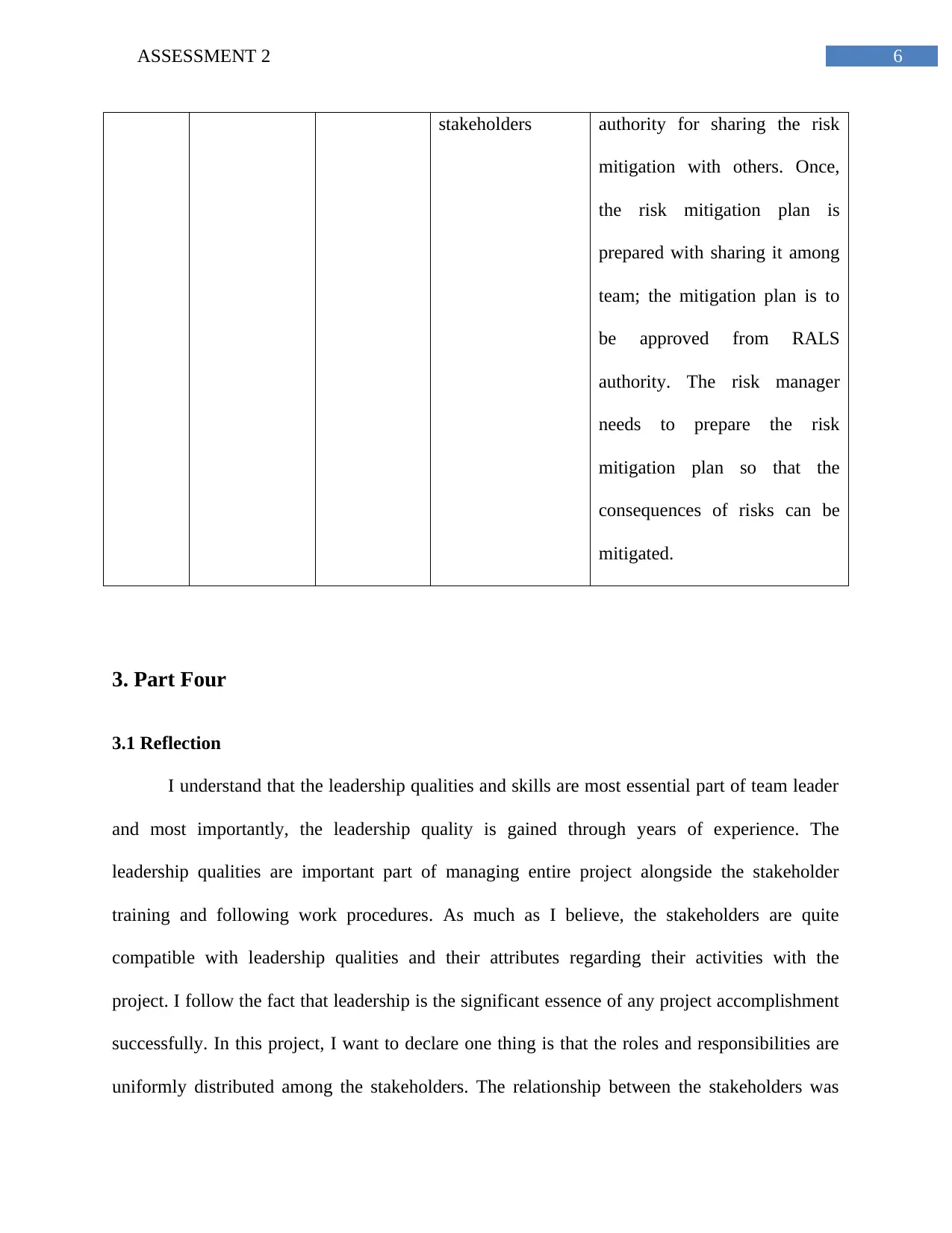
6ASSESSMENT 2
stakeholders authority for sharing the risk
mitigation with others. Once,
the risk mitigation plan is
prepared with sharing it among
team; the mitigation plan is to
be approved from RALS
authority. The risk manager
needs to prepare the risk
mitigation plan so that the
consequences of risks can be
mitigated.
3. Part Four
3.1 Reflection
I understand that the leadership qualities and skills are most essential part of team leader
and most importantly, the leadership quality is gained through years of experience. The
leadership qualities are important part of managing entire project alongside the stakeholder
training and following work procedures. As much as I believe, the stakeholders are quite
compatible with leadership qualities and their attributes regarding their activities with the
project. I follow the fact that leadership is the significant essence of any project accomplishment
successfully. In this project, I want to declare one thing is that the roles and responsibilities are
uniformly distributed among the stakeholders. The relationship between the stakeholders was
stakeholders authority for sharing the risk
mitigation with others. Once,
the risk mitigation plan is
prepared with sharing it among
team; the mitigation plan is to
be approved from RALS
authority. The risk manager
needs to prepare the risk
mitigation plan so that the
consequences of risks can be
mitigated.
3. Part Four
3.1 Reflection
I understand that the leadership qualities and skills are most essential part of team leader
and most importantly, the leadership quality is gained through years of experience. The
leadership qualities are important part of managing entire project alongside the stakeholder
training and following work procedures. As much as I believe, the stakeholders are quite
compatible with leadership qualities and their attributes regarding their activities with the
project. I follow the fact that leadership is the significant essence of any project accomplishment
successfully. In this project, I want to declare one thing is that the roles and responsibilities are
uniformly distributed among the stakeholders. The relationship between the stakeholders was
1 out of 7
Related Documents
Your All-in-One AI-Powered Toolkit for Academic Success.
+13062052269
info@desklib.com
Available 24*7 on WhatsApp / Email
![[object Object]](/_next/static/media/star-bottom.7253800d.svg)
Unlock your academic potential
Copyright © 2020–2025 A2Z Services. All Rights Reserved. Developed and managed by ZUCOL.





